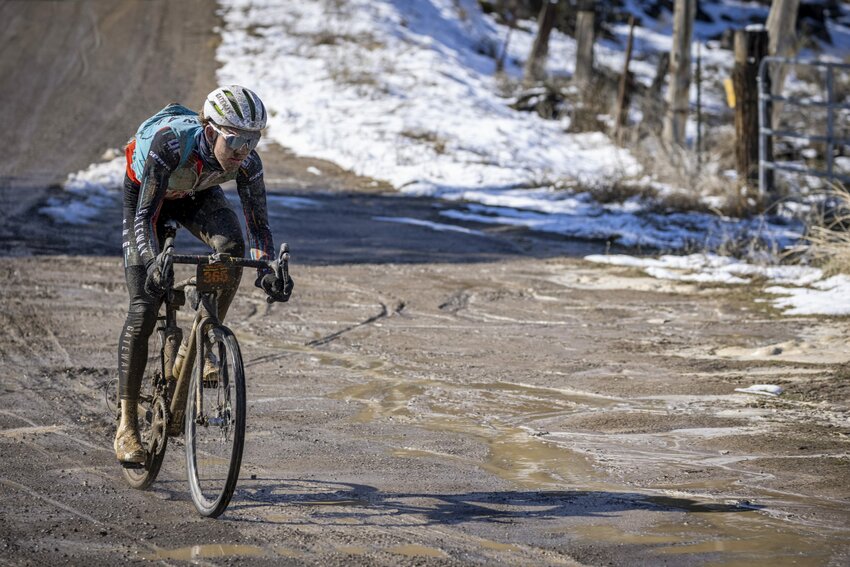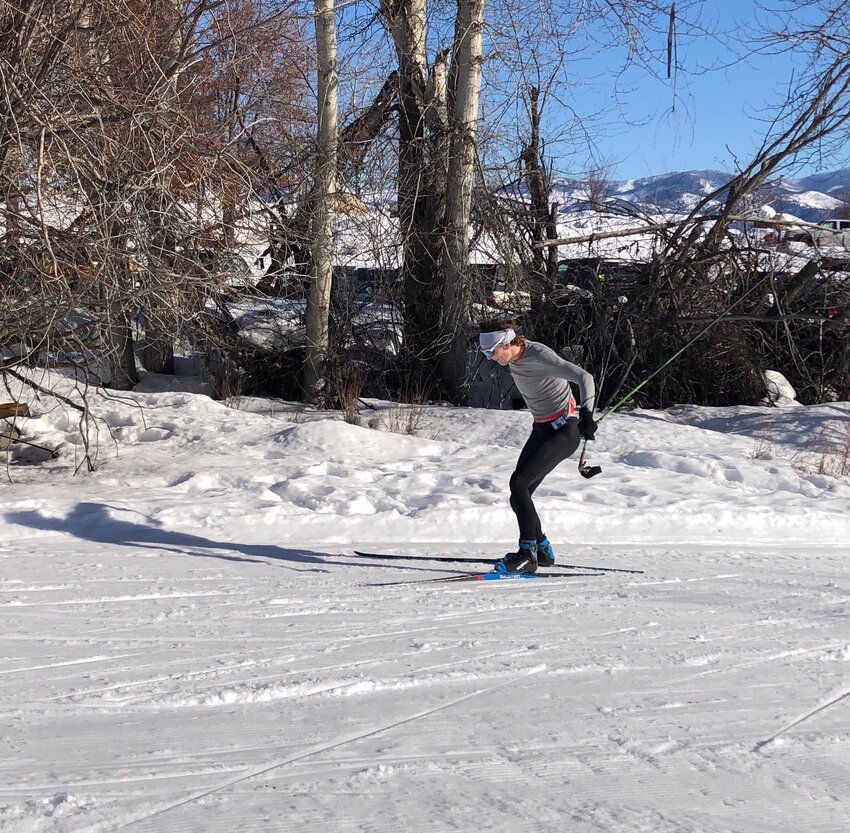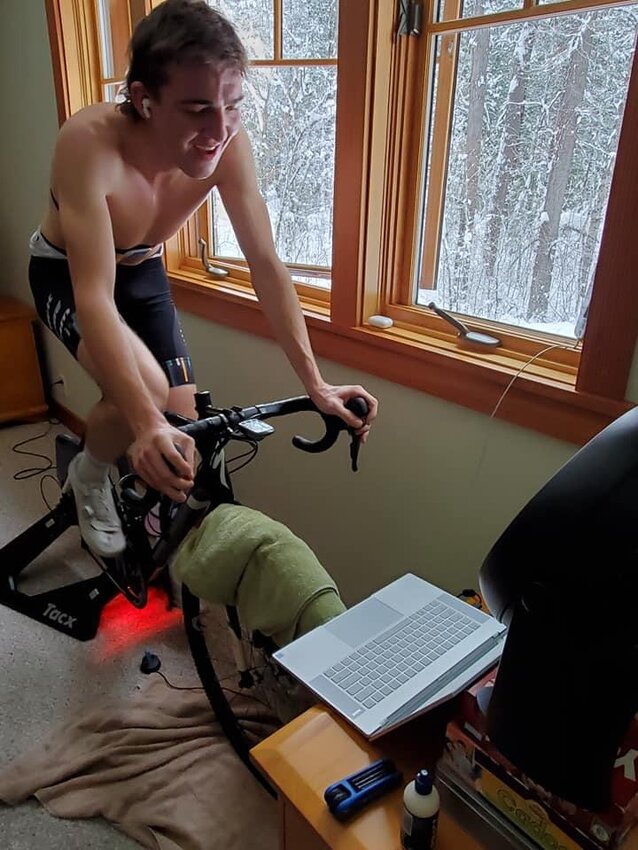 Jack Bardi races outside of Montague, California, at the Shasta Gravel Hugger. Sean Bagshaw photo.
Jack Bardi races outside of Montague, California, at the Shasta Gravel Hugger. Sean Bagshaw photo.I’ve been accused of taking on too much, but I don’t know how to live any other way.
On any given day, I try to fit in as many things as possible. As an athlete, the winter months are my favorite time to train. I can spend the morning skiing freshly groomed trails as the sun rises, come home, pull a crackly loaf of sourdough out of the oven, and then hop on my bike in the afternoon for a structured training session. In my mind, a day packed full is a day well spent.
For the last five years, bike racing has been my focus.
As a teenager, I fantasized about bike racing of all kinds. From the signature wet cobblestones of France and Belgium’s spring classics to the hot and dry climbs of Spain’s Vuelta a España, I wanted to do it all. The first racing I ever watched was the 2015 Tour of California. Seeing Toms Skujins solo to victory on the third stage made me realize that this sport is the sport I wanted to do. This drive to race the iconic monuments, stage races and grand tours is what has kept me focused since I was 14 years old assembling my first road bike with miscellaneous parts from the ’80s.
Now, 21, I race for Gateway Devo, a Trek-sponsored domestic elite team based out of St. Louis that races the professional circuit in the United States. We are an under-25 team that specializes in helping young athletes transition to the professional ranks of cycling.
In the off-season, each morning I start the day with my workout in mind, a couple cups of pour over coffee and a hot bowl of oatmeal. Then it’s straight to the wax room. Slight changes in snow conditions can drastically change the glide of the ski, and different conditions require different waxes, so waxing every day is crucial to skiing fast. This process is pretty simple, and only takes about 30 minutes (unless you burn your hand or drop the iron on your foot, like I did when I was 5 years old).
On weekdays, I’ll usually head out for a 90-minute or two-hour ski. On the weekend, ski sessions are generally three or four hours. Something about fast skis on firm snow makes even the longest and coldest ski sessions fly by.
 Jack Bardi in the Ski to Sun time trial in the Methow Valley. Janna Bardi photo.
Jack Bardi in the Ski to Sun time trial in the Methow Valley. Janna Bardi photo.I have been lucky enough to ski consistently every year. In 2006, my family built a house in Mazama, a small town in the Methow Valley east of the North Cascades that is home to the largest system of groomed cross country ski trails in the U.S. Usually, I get a few solid weeks on the trails before it's back to the west side and full time on the bike, but this year is a little different.
Due to the pandemic, my courses at Western Washington University are all online (oh yeah, I’m a full-time student as well). This gives me the opportunity to attend class from anywhere, meaning more time in Mazama, and more time on the skis. Instead of a few weeks, this year I plan to spend one to two months east of the Cascades, splitting my training between rides on the indoor trainer and on the skis.
After skiing, it is time to visit my dough. The processes for a full day of skiing, riding and baking actually starts around 10 p.m. the night before. This is when I make my levain for the next day’s batch of dough. The levain is a portion of the starter that is combined with flour and water separately and left to ferment until the dough is mixed.
Then in the late morning, I begin making the bread starting with the autolyze, where the flour and water are mixed together and then allowed to rest before adding the levain. This process gives the dough a chance to develop elasticity and flavor through enzymatic reaction before the fermentation starts. The initial mix lasts just a few minutes, but the full process takes roughly two hours. This ensures that the enzymes have enough time to work their magic.
For the last few years, I have been maintaining a sourdough starter. I feed it twice daily and store it in a warm corner of the kitchen. Because of this, the starter is always ready to go, and I almost always have something in the works. My most common bakes are the standard country loaf, tomato and onion focaccia, and pizza dough.
Although it may seem like a small hobby, bread is an important part of my routine (I am actually thinking about starting a local bread subscription service). It has become a therapeutic process, relieving the stress and tension of a jam-packed day.
The process of baking naturally leavened bread is lengthy, but mostly inactive. Because of this, I have found a way to structure my day so that I am riding, skiing or in class during the longer sections of fermentation, and free to perform stretch and folds, loaf shaping and baking during the gaps in my day.
In the early afternoon, I join my first Zoom class of the day. By the time the two-hour class is over, the levain is ready to be mixed into the dough. This marks the start of the bulk fermentation, the timed process in which the dough proofs at room temperature. This proof can take four to eight hours depending on the temperature of the room.
 Jack on the trainer, mid-180 bpms. Courtesy photo.
Jack on the trainer, mid-180 bpms. Courtesy photo.During the beginning stages of the bulk ferment, I capitalize on the inactive time to get my indoor ride done. This ride is generally one or two hours, sometimes serving as a recovery session from a hard ski, and sometimes as a focused interval workout. As it is not possible to ride outside with the snow levels and road conditions, I remove the back wheel of my bike and attach it to a stationary trainer, allowing me to pedal in place. This time spent indoors on the bike is an important part of my training plan. It fills in the gaps not covered by skiing.
After my ride, I find myself back in the kitchen once again tending to the dough. Although the fermentation is largely hands-off, the dough does require the occasional fold, where it is stretched and turned multiple times in order to develop structure. I generally find a few minutes here and there to perform a series of three or four folds during the ferment.
In the early evening I join my second Zoom class of the day. This class lasts an hour and a half, ending around the same time that the bread is fully proofed and ready to be shaped.
The process of shaping loaves is relatively simple but needs to be done correctly or the loaves will not rise properly in the oven. First, the dough is divided into 500g portions and quickly shaped into rough balls. After this initial pre-shape, the dough must rest for 20 minutes so that the gluten relaxes, then the balls are folded and shaped into tight cylinders called batards.
After the loaves are shaped, they are placed in proofing baskets and moved to the fridge where they spend the night. This section is the cold ferment, and it allows the bread to develop a sour flavor before it is baked the next morning.
The start of the cold ferment marks the end of the bread processes for the day. The rest of the evening consists of dinner followed by some yoga, stretching and any classwork that still needs to be completed.
I am usually in bed around 11 p.m., getting a solid night’s sleep so that I am prepared for another day of the same. x
 A loaf of sourdough. Jack Bardi photo.
A loaf of sourdough. Jack Bardi photo.Sourdough Formula (2 loaves)
Ingredients
1000g high protein bread flour
850g warm water
200g ripe sourdough starter
20g salt
Method
1) Start the autolyze by mixing the flour and water in a large bowl. Reserve 50g of the water. Let sit for two hours.
2) Add starter and 25g of the remaining water. Mix thoroughly until the walls of the bowl are dry and all the water has been absorbed. Let sit 30 minutes.
3) Add salt and final 25g of water. Mix thoroughly until fully absorbed and let sit 45 minutes.
4) Perform four sets of coil folds, each separated by 45 minutes. To do a coil fold, lift the dough from the bottom middle of the bowl and pull it up about a foot. Set it back down so it folds on top of itself. Repeat this a few times for one set. Once all coil folds are done, let the dough sit for one hour.
5) Pre-shape the loaves by turning the dough out onto an un-floured work surface and dividing into two equal loaves. Using a bench scraper, turn and pull the loaves against the bench so that it forms a taut ball. Let sit for 15 minutes.
6) Shape the loaves by lightly dusting the tops with flour and flipping them over. Grab the bottom section of the loaf and fold it up to the middle. Grab the left side and fold it across to the right. Do that same with the right. It should now resemble an opened letter. Grab the top middle section and fold it down to the bottom, leaving two ears of dough on the top right and left. Grab these and crisscross them down the center of the loaf. It should look like a laced shoe. Finally, roll the loaf up so it forms a tight cylinder and place bottom-up in a floured proofing basket. Let sit covered on the counter for 15 minutes.
7) Place airtight covered loaves in the fridge overnight, 12+ hours will yield a delightfully sour flavor.
8) Preheat oven and two Dutch ovens to at 500º for one hour before baking.
9) Remove the loaves from the fridge and turn out onto parchment paper. Score the tops of the loaves with a razorblade and place in Dutch oven. Bake, covered, at 500º for 20 min.
10) Remove lid and lower temperature to 450º. Continue baking for 20 minutes or longer if you like a darker crust.
11) Enjoy!